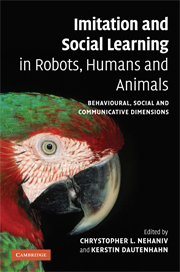 Imitation and Social Learning in Robots, Humans and Animals
Imitation and Social Learning in Robots, Humans and Animals Book contents
- Frontmatter
- Contents
- List of plates
- List of figures
- List of tables
- List of contributors
- Introduction: the constructive interdisciplinary viewpoint for understanding mechanisms and models of imitation and social learning
- Part I Correspondence problems and mechanisms
- Part II Mirroring and ‘mind-reading’
- Part III What to imitate?
- Part IV Development and embodiment
- Part V Synchrony and turn-taking as communicative mechanisms
- Part VI Why imitate? – Motivations
- Part VII Social feedback
- Part VIII The ecological context
- Index
- Plate section
Part VII - Social feedback
Published online by Cambridge University Press: 10 December 2009
- Frontmatter
- Contents
- List of plates
- List of figures
- List of tables
- List of contributors
- Introduction: the constructive interdisciplinary viewpoint for understanding mechanisms and models of imitation and social learning
- Part I Correspondence problems and mechanisms
- Part II Mirroring and ‘mind-reading’
- Part III What to imitate?
- Part IV Development and embodiment
- Part V Synchrony and turn-taking as communicative mechanisms
- Part VI Why imitate? – Motivations
- Part VII Social feedback
- Part VIII The ecological context
- Index
- Plate section
Summary
The two chapters in this section highlight the important role of social context and feedback provided in experimental teacher–learner setups for social learning and imitation in animals and machines (see Part III, What to imitate, this volume). Moreover, the articles exemplify social learning that occurs across species boundaries, including Grey parrots and a mobile robot, learning from human teachers.
In the first chapter, Irene M. Pepperberg and Diane V. Sherman discuss a particular training procedure called model/rival (M/R) where learning occurs in a triad consisting of the learner, the teacher (principal trainer), and a model/rival who serves as a model for the learner's behaviour and at the same time competes with the learner for the teacher's attention. This procedure comprises role-switch between model/rival and trainer, as well as extensive social interaction including positive and negative effects provided in response to correct or incorrect answers. It has been used very successfully by Pepperberg with Grey parrots, highlighting that the social context and feedback provided during the training sessions are vital for the success of the training. Some aspects of the procedure could be changed without significantly influencing the learning, e.g. adding a bird as another model/rival to the already existing triad. However, birds' abilities to learn decreased when interaction was restricted or removed (e.g. training in audio or video sessions).
- Type
- Chapter
- Information
- Imitation and Social Learning in Robots, Humans and AnimalsBehavioural, Social and Communicative Dimensions, pp. 379 - 382Publisher: Cambridge University PressPrint publication year: 2007
